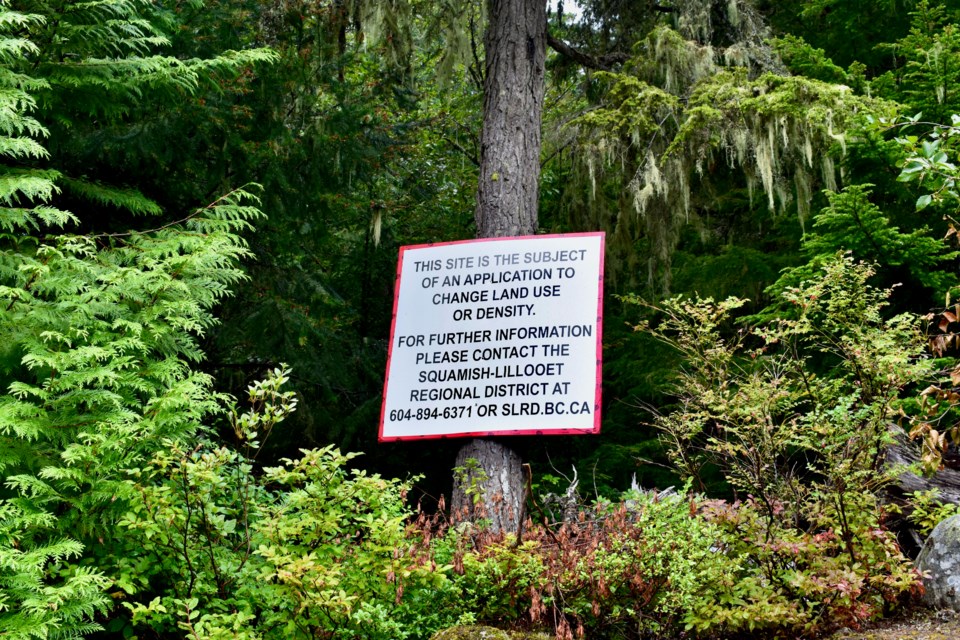The Squamish-Lillooet Regional District (SLRD) is considering a rezoning application for a 12-unit duplex development across from the WedgeWoods neighbourhood north of Whistler.
During a July 24 committee of the whole meeting, board members questioned whether the proposal adequately delivers on transit, affordable housing and fair use of amenity contributions—and whether those contributions balance out the cost of starting to develop on the west side of the highway,
“I've always been challenged by opening up the green side of the highway,” said SLRD board chair Jen Ford. "I've always been supportive of seeing this on the existing side of the development. I understand that there are reasons that people don't want that to happen.”
The development—located on the west side of Highway 99 in Electoral Area C—would cluster six duplex buildings on three lots, while reserving a fourth lot for servicing. All units are proposed as market housing, a shift from the original plan, which included four below-market rental units.
The development under consideration by the SLRD would also allow for a common facilities building, play area, visitor parking and units equipped with level 2 EV chargers.
Transit still a work in progress
Transit access remains a sticking point for the SLRD directors. The proposal includes a bus turnaround and shelter on the west side of Highway 99 to serve the development, as well as north- and south-bound commuters. But a lack of a confirmed crossing has left questions about access for existing WedgeWoods residents.
“[The Ministry of Transportation and Transit (MOTT)] is not supportive of an at-grade crossing or speed reduction in [this] location,” planner Alix MacKay told the board.
“We’re currently working with the proponent to assess the feasibility of a pedestrian underpass tunnel at that location that could enable people in the existing subdivision to cross over and access transit on the west side."
Some directors challenged the inclusion of transit infrastructure in the amenity package.
“It should be eliminated,” said Pemberton Mayor Mike Richman. “That’s a cost of doing business. That’s like supplying servicing ... I think it’s a little misleading to have it on the amenity package.”
MacKay clarified the $120,000 earmarked for bus infrastructure was listed under “greater community infrastructure,” rather than as part of the amenity package specific to the development. The new bus infrastructure is subject to approval from both BC Transit and MOTT.
From units to cash
The development’s amenity offering includes a $2.4-million cash-in-lieu contribution, replacing the previously proposed affordable rental units. Directors debated whether the shift aligns with the region’s housing priorities.
Richman said the original promise of below-market housing was part of what made the proposal appealing.
“Some of the willingness to contemplate this project was based around that there was housing generally being provided and some affordable units,” Richman explained. “The board then said, ‘Let’s look at taking that as cash-in-lieu.'
If the amenity is just cash-in-lieu and can be used for anything, he added, "it just makes me rethink about how I’m looking at this development.”
Other directors asked whether the funds could be earmarked for affordable housing in Area C. The SLRD’s director of planning and development services, Kim Needham, confirmed this would be possible under existing policy.
“If the board wished to make the amenity go towards the construction of affordable housing ... that could be [an Area C housing fund],” she told the board.
However, in response to a question from Director Chris Pettingill, she also pointed out Area C has limited capacity to support new standalone housing developments.
“Much of the electoral area is not serviced,” she explained. “So it’s very hard to find areas where we could land a large development where servicing could be provided on-site—outside of a well and septic field system.”
Local versus regional use
The broader question of how amenity funds are used sparked debate. While staff proposed the $2.4-million contribution be placed in a general fund and allocated later “by future board priorities,” some directors took issue with loosening geographic restrictions on those funds.
Area C director Russell Mack objected to the possibility of Area C funds being spent in municipalities like Pemberton.
“Normally ... amenity funds in the area that they're collected in are then used in the area that they're collected,” he noted. “What I don't want to see happen ... is amenity funds generated in an area all of a sudden go to a municipality to support their programs.”
Ford responded by citing past practice, including the use of funds from the first phase of WedgeWoods to support the Pemberton & District Community Centre.
“Yes, it happened in Pemberton, but it benefits the residents of Area C,” she said.
Needham clarified that under the SLRD's Community Amenity Contribution Policy, the director representing the area where funds are generated has the authority to make decisions on their disbursement. She added that funds designated for a specific use, like recreation, must remain so for seven years, after which they may be reallocated with board approval.
“One of the reasons we've suggested that the use of the amenity not be determined at this time is we didn’t want to see this application getting caught up in board discussions over how that money should be spent,” she explained. "Instead, that it could just go into a general amenity fund related to Area C or whatever the board were to determine, and then dispersal of those funds could happen after this application is determined."
Carrying on the conversation
The Lil’wat Nation wrote to the board, saying it would need further information before providing input on the rezoning and development. The Nation’s Land Use Referral Committee will review findings from a contracted archaeologist and provide feedback to the regional district. The timeline for the Nation’s response is unknown, based on the availability of an archaeologist.
The SLRD’s committee of the whole motioned to have more direction on a cash contribution being preferred over the construction of on-site below market rental housing, have staff research safe highway crossing options, and separate amenities specific to the development (like EV charging) from community amenity contributions.
Richman “reluctantly” supported the motion, citing his desire to keep the conversation around affordable housing and regional transit going.




